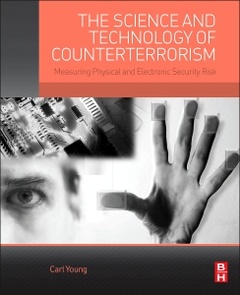Description
The Science and Technology of Counterterrorism
Measuring Physical and Electronic Security Risk
Author: Young Carl
Language: English
Subjects for The Science and Technology of Counterterrorism:
512 p. · 19x23.3 cm · Paperback
Description
/li>Contents
/li>Biography
/li>Comment
/li>
Scientists with little or no background in security and security professionals with little or no background in science and technology often have difficulty communicating in order to implement the best counterterrorism strategies. The Science and Technology of Counterterrorism offers the necessary theoretical foundation to address real-world terrorism scenarios, effectively bridging the gap. It provides a powerful security assessment methodology, coupled with counterterrorism strategies that are applicable to all terrorism attack vectors. These include biological, chemical, radiological, electromagnetic, explosive, and electronic or cyber attacks. In addition to rigorous estimates of threat vulnerabilities and the effectiveness of risk mitigation, it provides meaningful terrorism risk metrics.
The Science and Technology of Counterterrorism teaches the reader how to think about terrorism risk, and evaluates terrorism scenarios and counterterrorism technologies with sophistication punctuated by humor. Both students and security professionals will significantly benefit from the risk assessment methodologies and guidance on appropriate counterterrorism measures contained within this book.
Section I-Modeling Terrorism Risk1: Terrorism Threats, Risk and Counterterrorism Strategies2: Terrorism Scenario Analysis3: Terrorism and Uncertainty4: Physical Models of Terrorism Threats5: Measuring Terrorism RiskSection II-Analyzing Terrorism Threats 6: Conventional Explosive Threats7: Radiological, Biological, Chemical, and Electromagnetic Weapons 8: Electronic Terrorism Threats9: Electronic Security MeetsPhysical SecuritySection III-Counterterrorism Controls10: Affiliation, Authentication and Authorization11: Closed Circuit Television (CCTV)12: Physical Access Restriction and Security Incident Monitoring/DetectionAppendices:1-Linearity, Non-linearity, and Scaling2-Exponents, Logarithms and Measuring Sensitivity to Change;3- The Exponential Function, ex4-Parameters for Anti-Explosive Window Treatments5-Half-Life6-High-Level Counterterrorism Technical Strategies7-RFID Effects on Credit Cards in Close Proximity
- Offers a simple but effective analytic framework to assess counterterrorism risk and realistic measures to address threats
- Provides the essential scientific principles and tools required for this analysis
- Explores the increasingly important relationship between physical and electronic risk in meaningful technical detail
- Evaluates technical security systems to illustrate specific risks using concrete examples




